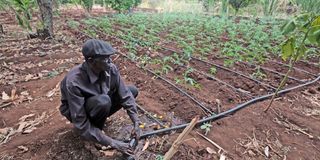Agronomist notebook: Best watering regime for tomato plants

A farmer connects drip irrigation lines to water his tomato crops. The drip lines should be checked regularly to ensure they are all working.
What you need to know:
- Tomato crops require adequate water for proper growth.
- In areas that receive high rainfall, the crop will not do well as the heavy rain ends up spreading fungal diseases.
- In dry areas, tomatoes are irrigated under drip, surface or furrow systems depending on the topography and water availability.
- Farmers in areas that receive high rainfall should plant tomatoes during the short rain season thus use irrigation.
Tomato crops require adequate water for proper growth. The crop can be rain-fed or irrigated.
In areas that receive high rainfall, the crop will not do well as the heavy rain ends up spreading fungal diseases.
In dry areas, tomatoes are irrigated under drip, surface or furrow systems depending on the topography and water availability.
Farmers in areas that receive high rainfall should plant tomatoes during the short rain season thus use irrigation.
When determining the irrigation system, consider the topography of the land, soil types and farm storage capacity.
Drip irrigation system
On Moses's farm, we are using the drip irrigation system since it's more efficient and requires little amount of water compared to furrow. The irrigation system was installed during land preparation. Our drip lines emitters are 20cm apart.
We have two lines of crop per bed, thus we are using two drip lines on each. The borehole water is first pumped into tanks and later distributed by pressure to the farms. This has saved Moses the cost of pumping water.
The frequency of irrigation depends on the growth stage of the crop and the soil type. For instance, after transplanting, the crop should be provided with sufficient water to prevent it from drying.
Excess watering results in water-logging, creating a conducive environment for damping off. At the flowering and fruiting stages, one also needs to supply more water to the crop.
Currently, we are watering our tomatoes thrice per week. On average, we are using 2,800 litres of water per week under the drip irrigation system, depending on the soil moisture content.
When it rains, we do not water the crops. However, during the rainy season, we protect our crop against fungal infections by spraying a copper-based chemical.
Leaching of nutrients
Before watering, we determine the level of soil moisture by using a moisture tester. Alternatively, one can do a simple test by holding the soil on the palm and rolling it. If it forms a ball, it shows the water is adequate. If it does not, it shows one should continue watering.
Consider mulching the crops with dry grass to preserve moisture and reduce the frequency of watering.
While watering, Moses ensures he does not overwater as this results in leaching of nutrients and waterlogging.
The latter creates a conducive environment for fungal infections to occur. Initially, we had a portion of land flooded as a result of leakage on the drip lines.
Checked regularly
The drip lines should be checked regularly to ensure they are all working and the blocked drip lines unblocked by the use of phosphoric acid or flushing them out with running water.
While carrying out management practices such as weeding, ensure the drip lines are not damaged. Repair should be done on broken lines.
Also, ensure the drip lines are between crops on the bed, as this ensures the supply of water is adequate for the crop.
Irrigation should be done when weather conditions are calm in the evening or morning to prevent water loss due to evaporation.
Our tomatoes are now at the flowering stage while others already have small fruits. In our next article, we shall focus on physiological disorders that re likely to affect our tomatoes.





